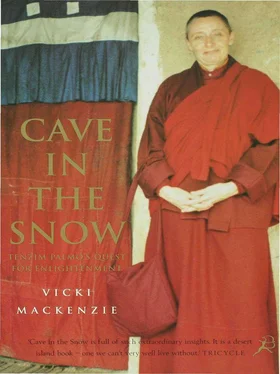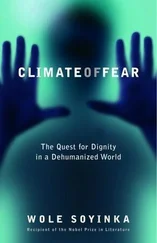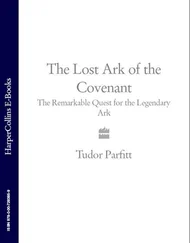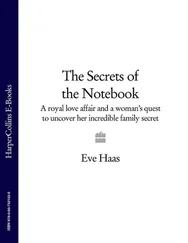‘I think the skilful incorporation of certain psychological principles is going to be very significant. I also like the idea of social involvement, of genuinely going out there to help others rather than just sitting on the meditation cushion thinking about it. It’s opening the heart through practical application and it suits the West. Actually, it’s not inimical to the dharma, it’s always been in there, but lying a little bit dormant. Different aspects of the dharma emerge when they resonate with certain qualities in the psyches of the people it is meeting. It’s an absolutely necessary process if Buddhism is going to be applicable to one’sown country.’
‘But these are very early days. The dharma took hundreds of years to get rooted in Tibet. There’s no Western Buddhism yet. Buddhism will not be rooted in the West until some Western people have gone and taken the dharma and eaten it and digested it and then given it back in a form which is right for Westerners. At the moment it is like that period in Tibet when they went to India to bring scriptures back and Indian masters visited Tibet. Only gradually did the Tibetans evolve it into a form which was right for them, just as the Thais or the Burmese did. Westerners are going to do that too eventually, but it has to come very naturally.’
In the context of Tenzin Palmo’s story, however, it was the rise of feminism in the West which brought with it the most interesting rewards, and the sharpest challenges.
Chapter Sixteen
Is a Cave Necessary?
While Tenzin Palmo had been secreted away in her cave doggedly pursuing the path to perfection, the women of the West had been busy out in the world organizing their own revolution. By the time she came out they had made significant inroads into the male strongholds of both the public and private sector and were turning their determined and increasingly confident eye on the last bastion of male domination, religion. Buddhism was not spared. It might not have had a ‘God the Father’ to contest, believing as it did in a genderless Absolute, but like all the world’s great faiths it had been formulated by men according to men’s rules in a time when men were the undisputed leaders. But times were rapidly changing and the old order was giving place to the new. The emerging breed of powerful feminist Buddhists began to query some of the very fundamentals that lay at the heart of the ancient tradition that Tenzin Palmo was following so faithfully, and started to demand a more feminine face for the Buddha.
Their questions were sharp and far-ranging. Instead of the masculine hierarchical structure, which had been in place for millennia, which placed the head at the top and the rest of the community fanning out underneath in a triangle, why shouldn’t the head be in the centre of the circle with everyone else at equidistance all around? Why were places of worship always built in straight lines? Why weren’t they round instead, following the more feminine principles of the circle and the spiral? Why wasn’t the quality of nurture included in the practice? Why wasn’t there more emphasis on the sacredness of the body and embodiment, rather than the ideal perpetually being depicted as something transcendent? Why wasn’t earthiness as holy as the de-material? Why weren’t relationships more honoured? And why were the female consorts of divine art always depicted with their back to the viewer, their role thereby being subtly projected as secondary to the man’s, although in effect they were as essential to the process of spiritual unfolding as their male partner?
More significantly to Tenzin Palmo’s quest, they asked, is a cave necessary? A cave, they said, was a male prerogative which seriously disadvantaged women with children, spouse and house to care for. While men can (and do) walk away from their families, as the Buddha himself had done, to engage in long bouts of solitary meditation to improve their spiritual chances, women cannot, or do not want to. Why should the maternal instinct, which after all was responsible for bringing forth all beings into the world, including the Buddha, the Christ and all the other holy beings, thus be regarded as a handicap? The cave (or the forest hut), with its call for total renunciation of the world, was, they said, a patriarchal ideal which had held dominance for too long.
As had happened in other fields of feminism, spiritual women now stated they wanted it all. Spirituality and family. The cave and the hearth. To this end they began to initiate practices which included children and families. They introduced emotional healing as a way of meditation rather than the enemy of it. They made moves to change the liturgy and the sexist language of the prayers and ritual. And they brought home the point that the kitchen sink was as good a place to reach Enlightenment as the meditation hall or the remote Himalayan cave. It was revolutionary stuff, which promised to change the face of Buddhism for ever.
Tsultrim Allione, an American woman, was at the forefront of the movement. She had been ordained in 1970 but had disrobed four years later to get married and have children. She went on to write Women of Wisdom , one of the first books to laud the place of the feminine in Buddhism, and later established the Tara Mandala Retreat Centre in Pagosa Springs, Colorado, which she set up along the new, experimental feminist lines. She was in a prime position to know both sides of the story. ‘I disrobed because I was the only Tibetan Buddhist nun in the USA at that time and felt very isolated and unsupported,’ she said from a loft in Seattle, where she was presenting a talk and slide show of her recent visit to female holy sites in India and Nepal. ‘I was twenty-five, my sexual desire was there, and celibacy began to feel like suppression. What came out of that was that I went from being a nun to a mother and a writer in a year. It was an intense experience - and definitely the best decision for me. From having all the time to myself I had no time to myself. From thinking I’d overcome jealousy and anger, and all those negative emotions, they were now all thrown back in my face. It made me realize that as a nun I was protected from feeling them. I had to grind deeper into the layers of the five poisons to see what they were and learn to work directly with them and not cover them up. If I had stayed a nun I could have become very arrogant, thinking I was above them all,’ she said.
Tsultrim Allione went on to have four children in five years (one of whom died in infancy), an experience which made her dispute the rigid ‘official’ line that motherhood was an obstacle to spiritual progress. ‘We have to ask ourselves what spiritual realizations are. The whole maternal impulse is the same as the urge of love and self-sacrifice. Realizations have been defined by men and as such they are events which are “up there and out there”. They are not the experience of embodiment. The giving instinct of a mother is detachment. And there’s a quality of really understanding the human condition from being a mother and a lay person which you do not get as an ordained person. As a mother I was constantly disillusioned with myself. I chose how I failed, not if I failed.’
For herself she had no doubts that a cave was unnecessary. ‘I believe women can become Enlightened in the home,’ she said. ’That’s the whole point of tantra. There’s a story about a woman who always used to do her practice while carrying water. One day she drops the water and as she does so her consciousness breaks open and she experiences Enlightenment. The tantric teachings actually came out of a protest movement of the lay community against the monastics which resulted in two systems with two different sets of ideals. There is both the tantric paradigm and the monastic paradigm which one can follow.’
Читать дальше












